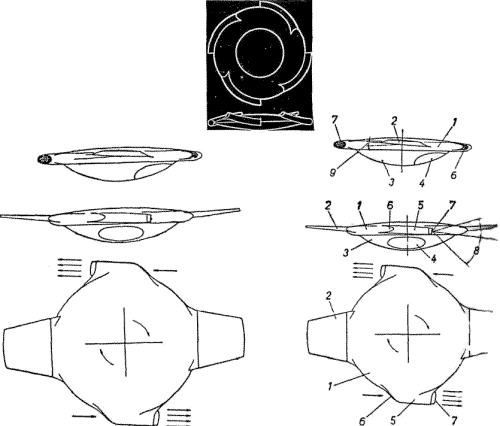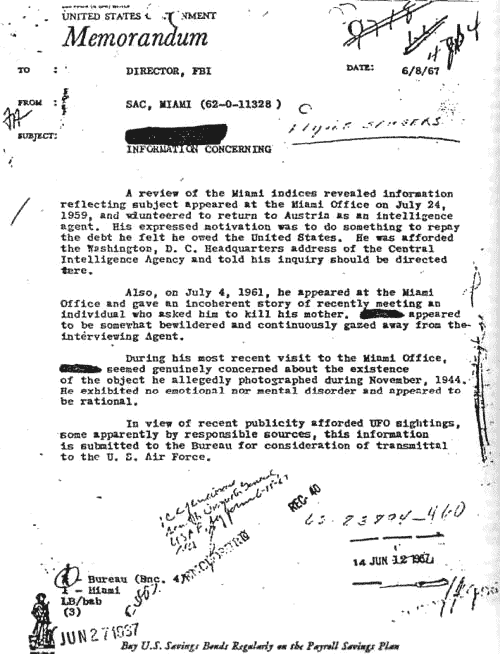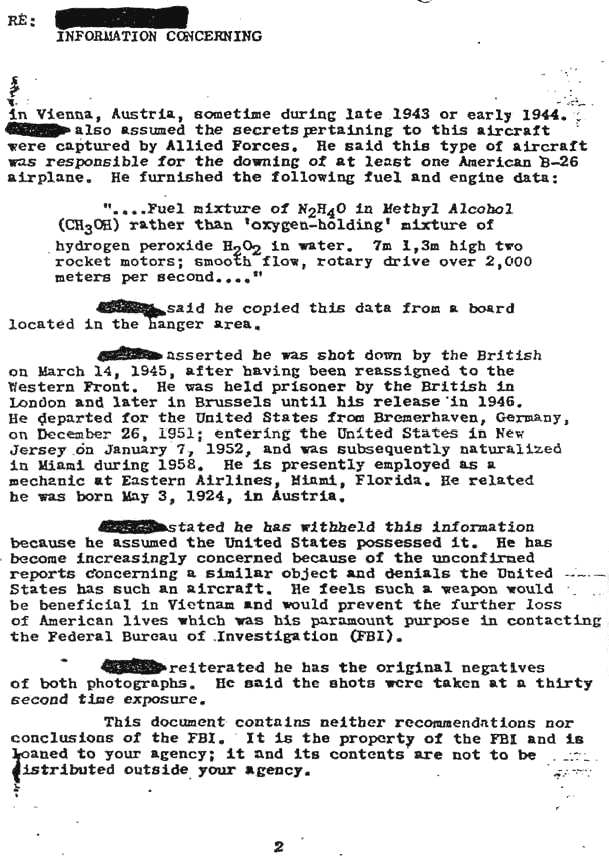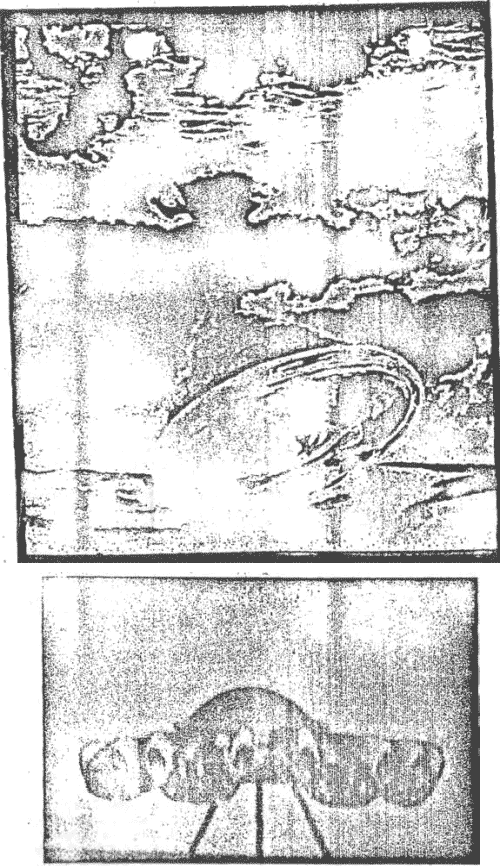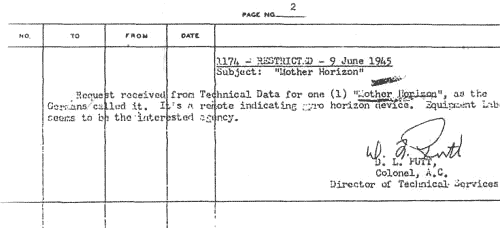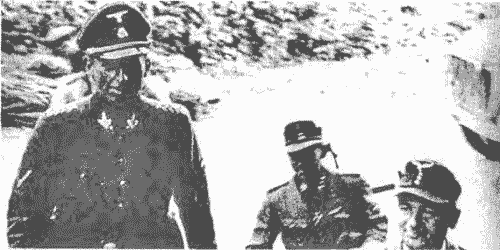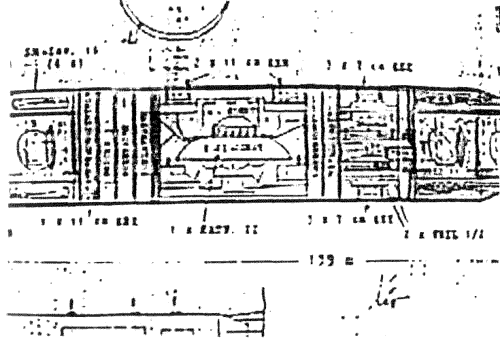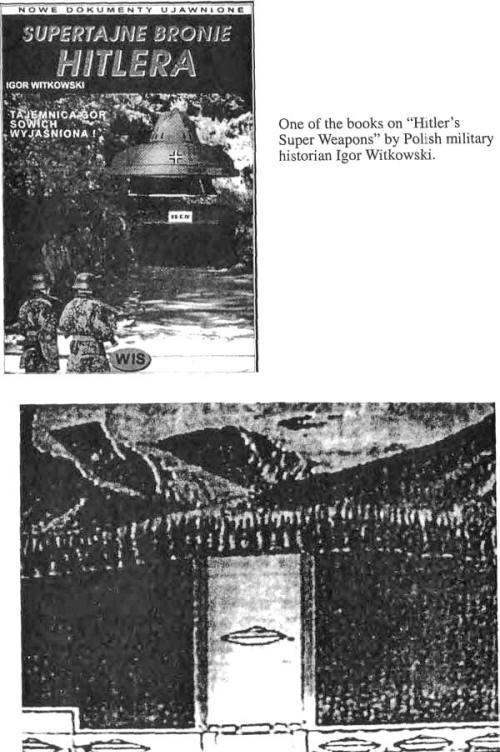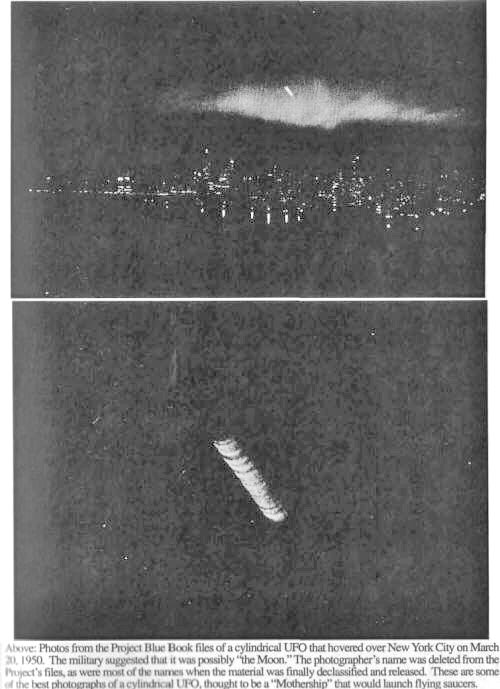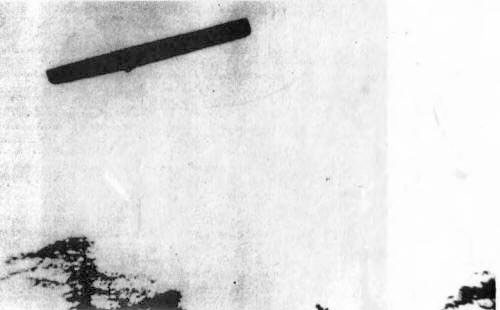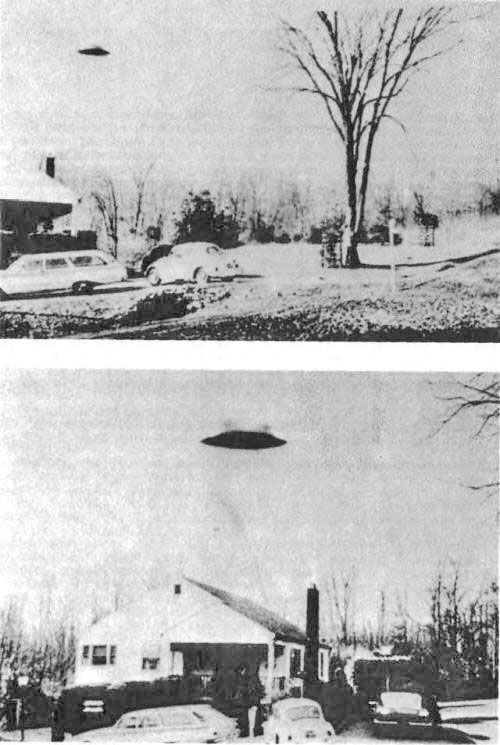CHAPTER FIVE:LORE AND LOOSE ENDS: A DISCUSSION OF GERMAN SAUCERSSome of the historical context for German flying discs has been discussed in the preliminary section of this presentation, "The Situation Within Nazi Germany". German saucers were not designed to generate the flying saucer mystery in the second half of the Twentieth Century. They were designed as a weapons system to do a specific job. The fast-moving wartime mind-set was a time when new aircraft designs and new propulsion technologies were coming on line with increasing frequency. The insertion of these saucer-craft into the wartime fabric did not seem as culture altering as the disclosure of these same craft might be to us today. But a simple recitation of the facts is not enough. Some things need to be said about the ideas on German saucers in order to put their study in a better context. Also, some strings have been left untied and some ideas need to be mentioned in order to round out the discussion on this topic. No better place to start exists than with Renato Vesco. Vesco's insights for the reasons for German saucers were right on the money as were his descriptions of cultural conditions within wartime Germany with prompted this response. Vesco elucidated the foo fighter mystery as nobody else did. But he went on to describe another mystery craft which he called the "Kugleblitz" or "ball lightning" in English (1). This craft is not the same as the Schriever, Habermohl, Miethe or any other saucer design so far disclosed. Indeed, Vesco seems to know nothing of these other projects. His only descriptions were of the Feuerball (foo fighter) and the Kugelblitz. Vesco described Kugelblitz as the big brother of the Feuerball, meaning that it was a further development of the Feuerball or foofiqhter. A central cupola or cabin was surrounded by a free-spinning body or saucer which was turbine driven. Further stabilization was probably provided by a small but rapidly spinning centrally positioned flywheel, a gyroscope, set at ninety degrees from the axis of the saucer. The Kugelblitz was able to take-off vertically. Its method of destroying enemy aircraft was probably that described by Vesco (2) and confirmed in new U.S. government documents which included the description of the "Phoo Bomb" (3) under item six, "Gases Applicable To Aircraft". In this system the Kugelblitz approached an enemy bomber formation and ejected one of two types of gas ahead of that formation. The engines of the bombers inhaled the gas and were either destroy by pre-ignition or engine seizure caused by loss of motor oil viscosity. It is not know if one or both methods were used. The Kugelblitz was guided to the bomber formation by a homing device whose name may have caused Vesco and later UFO researchers some confusion. This is because there existed a homing device whose name was "Kuglelblitz". This may have caused Vesco to assume the entire project bore its name. This device was manufactured by the Patent Verwertungs Gesellschaft of Salzburgand we know quite a bit about it through a Freedom Of Information Act response (4). Curiously enough, and for a second time, the file comes to us from the Federal Bureau of Investigation, a domestic spy agency which theoretically had no business investigating foreign technology in foreign lands. The Kugelblitz homing device was a proximity fuse which measured radio frequency waves bounced back from the target, reconciling the Doppler shift with measurement of standing waves to find the exact distance to the target. This homing device was the best of any produced by the Germans, according to the report, as was to be used on all varieties of flak rockets including the Schmettlerling and the Rheintochter. Examples were built at the Patent Verwertungs Gesellschaft plant but it never reached full assembly line production. There are two interesting asides to this story. The first is that on May 1, 1945, one day after Hitler shot himself in the bunker and six days before Germany surrendered, two officers of the Reichsministerium fuer Rustungs und Kriegsproduktion (AlbertSpeer's ministry) arrived at the plant and took all existing examples of the Kugelbitz devices and the plans. Neither the two officers, the devices, nor the plans were ever seen again (5).Why was this done? Realistically, these officers must have had some post-war aspirations for this device. It must be added that at this point in the war, Speer's ministry, the Reichs Ministry for Armament and War Production referred to above was in fact being administered and run by the SS. The second aside is another device in the conceptual stages at the Patent Verwertungs Gesellschaft called "Phantoscope".Phantoscope was to employ high frequency waves beamed to the ground then reflected and picked up on board a moving aircraft to image, in three dimensions, the contours of the earth's surface using a glass case filled with gas and tiny vertical wires. This could be done in any weather, day or night (6). One wonders if the German officers plucked this jewel also? If so, was this to be used on a manned saucer? Vesco says the Kugelblitz saucer was flown once against enemy aircraft (7). It was destroyed by technical detachments of the SS after "a single lucky wartime mission" (8) in late March or April of 1945 (9) . Another mystery is the post-war activities of Dr. Richard Miethe. Most all sources state that Dr. Miethe went to Canada after the war and worked on a joint Canadian-American saucer project at an aircraft facility near Toronto, Ontario. Unfortunately, all Freedom Of Information Act inquiries concerning Dr. Miethe run into the solid wall of "no record". Only one researcher ever claimed to have a document naming Dr. Miethe in association with this Avro Aircraft, Limited project, (also known as A.V. Roe,Limited), and that one researcher later admitted to being "a government asset" which throws a cloud of doubt on all his work(10). There is no doubt, however, that by early 1955, work was commenced by Avro to build a mach 3 flying saucer which is reminiscent of some of the designs attributed to Dr. Miethe. Two designs were proposed, the difference being the engine used to power the saucer. One proposal was to use several axial-flow jet engines. The second and preferred proposal was to use one large radial-flow jet engine. The axial type is the type most commonly used in jet aircraft today. The radial type was similar to the first jet engine flown by the Germans in 1937. In fact, the radial engine actually under study in Canada may have had some similarities with the Rene Leduc engine used by Dr. Miethe. Work continued until the early 1960s under various names including Project Silver Bug and Project 1794. Finally, a small hover-craft was unveiled by Avro as the final outcome of their saucer experimentation. This "Avrocar" had nothing to do with either Dr. Miethe's work or a mach three interceptor. The Avrocar was probably a cover project for something else. This "something else" was more advanced. The Avro Aircraft, Limited experimentation with saucer-craft was always an open secret which was at times exploited by the government. Information regarding this project has been obtained via Freedom Of Information Act using their American partner, the United States Air Force at Wright-Patterson Air Force Base, by this researcher as well as other researchers. There exists a sub-story to the Canadian involvement which should be mentioned. In an article in a British UFO magazine, writer Palmiro Campagna revealed a previously unknown connection between the Canadian government and the history of German saucers (11).It seems that an SS technical liaison officer, Count Rudolf von Meerscheidt-Huellessem, (erroneously spelled "Hullessem" in the article), contacted the Canadian government in March of 1952,offering technical information about a German saucer which could attain speeds "limited only by the strength of the metals used An the saucer's construction". According to the article, von Meerscheidt-Huellessem wanted a large sum of money as down payment, a monthly salary and Canadian citizenship and police protection in exchange. Support for this claim comes in the form of copies of Canadian government documents describing this offer.Mr. Campagna states in the article that the Canadian government ultimately declined the offer but that the American government may have taken over negotiations and accepted. Avro Flying Saucer  This is a general diagram of the exterior of an Avrosaucer. It is representative of how the Avro radial engine saucers worked. Within this outer hull an inner, flatradial-type engine of was situated. This is exactly the scheme designed by Dr. Richard Miethe it and has been copied from his designs. Dr. Frost and his engine designs were overblown, heavy, complicated frauds. Contact was made by this researcher with a daughter of Count Rudolf von Meerscheidt-Huellessem's who verified that her father was a technical liaison officer. She had little contact with her father since she was two years old since he had remarried and moved to Canada. She was able, however, to provide the address of another relative, Countess von Huellessem, who was Count Rudolf von Meerscheidt-Huellessem's widow. Contact was made with Countess von Huellessem. Count von Meerscheidt-Huellessem died in 1988. But the Countess did know a little something about the story in question. Her late husband did discuss the flying saucer with her but only once. He told her that the "drawings" had been given to a representative of the Canadian government in 1952. After review of the drawings, the only comment from the representative was that they were "outdated". The drawings were never returned. The Canadians had succeeded in obtaining hard information concerning a real flying saucer and in paying for it with an insult. Count von Meerscheidt-Huellessem was somewhat despondent over the rejection. He never mentioned the subject to his wife again. At the time they were both making new lives for themselves in Canada and the subject never resurfaced. In discussing these events with the Countess over the telephone, she told me that she herself had seen these drawings. She was asked if these were drawings or technical plans. She said they were technical drawings on rolls of paper. I said the word "blueprint" and she said "yes". She stated again that these drawings were given only to the Canadians and not to the Americans. Countess von Huellessem was sent a copy of the aforementioned article. Her only comment was that her husband would not have asked for a large sum of money in exchange for this information. They already had means. He might have asked for a position, she said, since her husband would have enjoyed working on this project. Returning to the Avro Aircraft, Limited - U. S. Air Force saucer project, we have to ask ourselves some questions. First, was this information, these plans, the real basis of the Avro saucer project? This would certainly explain the reason for the partnership between the two governments involved since the Americans would have needed the Canadians at that point and the Canadians would have insisted upon control of the project on their home soil. Second, did the technology brought to the Canadians by von Meerscheidt-Huellessem have anything to do with the jet technology obtained the under Freedom Of Information Act? It certainly had nothing to do with a hover-craft which was the outcome of this project according to the government. How could a floppy hover-craft barely capable of 300 miles per hour under the best of estimates have had anything to do with a saucer whose speed was "only limited by the strength of metals used in the saucer's construction"? Could Project Silver Bug, Project 1794, and some of the other patents of John Frost attributed to this collaboration all be nothing more than an elaborate cover story? Another point is that until recently, the only connection linking the German saucer projects to the Avro Project and to the Americans was the involvement of Dr. Richard Miethe. With the new evidence of the Peenemuende Project's connection to the American saucer projects run out of Wright Field, Ohio and the Count von Meerscheidt-Huellessem connections to the Canadians, the weak linkage of Dr. Miethe to these projects is superfluous. There is now more than enough evidence to make these connections with or without Dr. Miethe. Further, considering the Count von Meerscheidt-Huellessem evidence, there is now a direct link between German saucer technology and the Canadian government's saucer project at A.V., Roe Limited. That link turns out to be the SS in the form of an SS technical liaison officer. There are differing opinions as to how known saucer-types were actually powered. Every researcher seems to have his own ideas about this subject. Could the answer to this dilemma be that there are more types of German saucers than we know about? For instance a device is depicted in a 1975 issue of Luftfahrt International, a well respected German aeronautical magazine, which shows a drawing of a "Flakmine" (12). Depicted are several rotor blades, some powered by ram-jets, making it essentially a jet-powered helicopter. This device may have been derived from design work done in Italy in which the propellant and the explosive were the same substance. This device was called the "Turboproietto" meaning in English, "turbine projectile" (13).It would have been able to carry large quantities of explosive to the altitude of a bomber formation. The device would have rotored up, vertically, to the level of a formation of bombers and then detonated, using the remaining fuel as a bomb,presumably inflicting heavy losses. Klaus-Peter Rothkugel refers to this very device as a "Drehfluegel" and will detail its development in his upcoming book. In another instance of a possible saucer type, saucers shown to Bill Lyne in a movie clip while he was in Air Force Intelligence were described by him as "flying turtles" (14). This film was taken by B-17 flight personnel during World War Two as the two German saucers attacked a squadron of bombers. other writers including Michael X. Barton and Norbert Juergen-Ratthofer used these same descriptive words. Vesco describes the "Feuerball",the foo fighter, as "circular and armored, more or less resembling the shell of a tortoise". This description also applies to his Kugelblitz (15). Turtle or tortoise is "Schildkroete" in German. Sometimes this device is referred to as a "flying turtle" in both languages. With so many writers using this term for flying craft which are apparently not all similar, there exists a certain amount of confusion about this name, "Schildkroete". Therefore, this saucer does not seem to fit neatly into any previously described saucer type. Perhaps this flying turtle is only another name for the Fireball or foo- fighter which seems to be the consensus among German writers, other writers seem to associate this word with a larger craft so perhaps this type of saucer is closer to what Vesco described as the Kugelblitz. "Schildkroete" seemed so nebulous that for many years this writer refused to accept the term at all. This all changed when it was uncovered that the Germans were actually developing a flying weapon code-named Schildkroete. This researcher as well as another researchers have found references to an offensive air weapon, called by the Germans, "Schildkroete", and known to American intelligence. The exact nature of this device is, however, still kept secret. The government is uncooperative, even when presented with their own words on the subject and copies of their own reports. For instance in a Combined Intelligence Objectives Sub-Committee interrogation of Albert Speer, Reich minister of Armaments And War Production, report 53(b), Speer is specifically asked about"Schildkroete". Only Speer's reply is retained in the record,not the actual question. Line number 20 of that interrogation quoted here as the document from microfilm is difficult to read: " 20. Schildkroete he was not sure about, but he thought is might, conceivably be a jet fighter. " By the time Schildkroete had come about, Speer had lost much of his standing and duties to officials of the SS. In this same set of interrogations Speer deferred a question concerning V-weapons to Dr. Hans Kammler as the one the Allies should seek as the expert. Speer was the only one raising Kammler's name. There was no follow-up questioning by the Allied interrogators. It was almost as if Speer had uttered an obscenity, invoking the "K"word, which was a word simply too hot to be touched in that setting. The next Allied reference to Schildkroete comes from the Combined Intelligence Objectives Sub-Committee, Evaluation Report 40, titled "Sonderausschus A-4". Sonderausschus was an organization whose job it was to prioritize resources toward projects most needed to defend the Reich. These high priority programs were the Vierjahresplan, Vulkanprogramm, Jaegerprogramm, Lokprogramm, and the Notprogramm. Each had projects within these headings.Even though under pressure of law in the form of a request under the auspices of the Freedom Of Information Act, the Federal Government of the United States of America has responded with a"No Record" when asked for their files on some of these programs.This is true even when confronted with their own documents naming these programs. One project, project 8-162, clearly names Schildkroete as the code-name of this project. It is listed in association with a known project, the "Salamander" project, which resulted in the He 162A Salamander or Volksjaeger jet fighter. U.S. Government Documents Mentioning "Schildkroete" 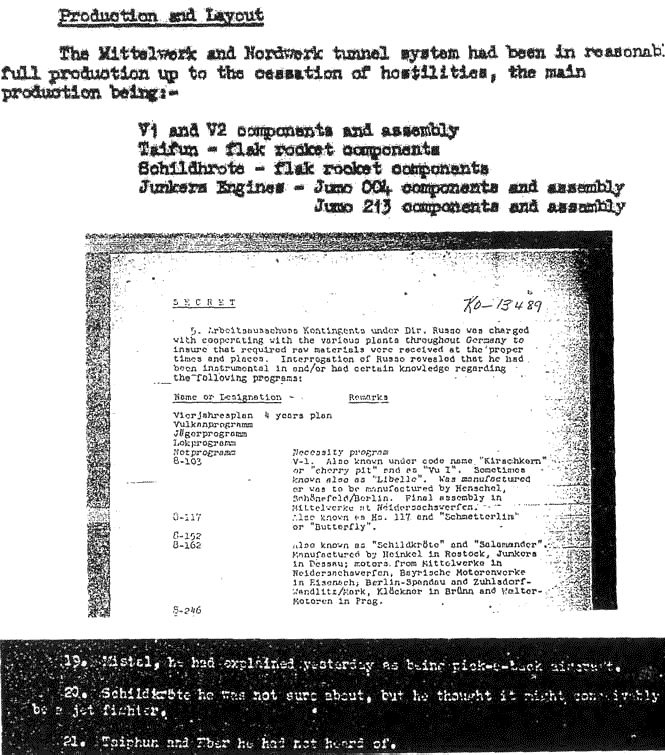
Top: Combined Intelligence Objectives Subcommittee (CIOS) Report items 21, 22, 31, File# XXX111-38 Underground Factories In Germany, page 19. Middle: CIOS Report 40, Sonderausschus A-4, page 5. Bottom: CIOS Report 59(b) Interrogation Of Albert Speer Reich Minister Of ArmamentsAnd War, Page 3 The last reference to Schildkroete was found by Heiner Gehring in the Combined Intelligence Objectives Sub-Committee Party 536 report on Underground Factories in Germany. This was classified as "Secret" and was a G-2 Division, S.H.A.E.F. report! In describing the large underground facility at Nordhausen, where the bulk of the V-2 production took place, tunnel divisions Mittelwerk and Nordwerk were said in this secret report to be producing "Schildhroete - flak rocket components". Although spelled incorrectly in the report, the intended word is very apparent. Clearly something is going on under the heading Schildkroete. A possibly is the connection of Schildkroete to the Italian "Turboproietti" mentioned by Vesco. In an information sheet,Klaus-Peter Rothkugel depicts a diagram for the Turboproietti. This design is remarkably similar that found in Swiss newspaper from the mid-1950s (16). This article credits the successful German saucer program and Georg Klein and goes on to describe another related design which is reproduced here. One can immediately see the relationship with the Turboproietti design.In this design the center of gravity is below the saucer surface adding stability. The pilot's cabin is also below the wing surface. This is curiously similar to a turtle's bony structure in which the head and neck emerge from under the turtle's shell. Could this have been the Schildkroete design? This design calls for the use of ram-jets but turbojets could have also been used. Fuel tanks are located in the rotating wing and so fuel is fed to the jet engines by centrifugal force. The two small wings have adjustable angles as do the jet engines themselves. Thus, the method of vertical flight is similar to the Schriever-Habermohl saucers. The horizontal maneuvering is unique and warrants discussion. We have all heard reports of flying saucers in flight making seemingly non-aerodynamic turns instantaneously. In this article, Mr. Zollikofer proposes a simple method to accomplish this. It involves angular momentum. We all remember seeing a child's top spinning on a smooth floor. Perhaps the reader will recall that when the top nears a piece of furniture and hits it,the top shoots off instantly in the opposite direction. This happens because contact with the furniture caused a change in the top's angular momentum. The top's momentum was braked on one side. A sudden slow down on one side caused an imbalance whose force drove the top to the opposite direction. In this same way the intentional slowing of one engine (on one side) on this saucer design would cause the rapidly spinning saucer to instantaneously change course, shooting to the other side. Several of these course changes would resemble insect- like flight to the observer. The rapidity of the course changes is tied to the degree of slow-down or breaking of the saucer's angular momentum and to the degree (revolutions per minute) of that momentum. Even when stationary, increased spinning would serve as a "bank" of angular momentum to be drawn upon at a moment's notice. "Turbopriette" And A Possible Successor Top: Italian designed "Turboproietti" an anti-aircraft design which used left-over fuel as its warhead. Bottom: Saucer design, 2/3/55, "Neue Zuercher Zeitung". 1. Hub of the rotating winged-wheel. 2. Adjustable wings 3. Non- rotating cabin. 4. Lookout for the pilots. 5. Ram-jets 6. Air intake. 7. Exhaust, direction changeable. 8. Angle of variation of the exhaust rudder. 9. Variable adjustment angle of the wings. Was this a Schildkroete? Kugelblitz? Through out Vecso's Intercept UFO the words "circular wing" are mentioned. Looking at this design yields a possible new understanding to that term. It is possible that this basic design is to be found in the foo fighter, (Feuerball, Phoo Bomb),as well as the mysterious Kugelblitz. It was hinted above that this design may be the basis of the Schildkroete but it could also be the basis for other German saucer projects. Many writer attribute field propulsion to the foo fighter. This is because of its luminosity, its flight pattern and its alleged disruption of ignition based aircraft engines. Another possibility is that it was a jet propelled flying machine but with one addition. It is possible that a T.T. Brown-type of flame-jet generator was attached to its exhaust nozzles and the appropriate insulation added on the surface of the craft. With this addition, the exhaust gasses would become enriched with negative ions. So would the air in the surrounding vicinity. This would have resulted in the short-circuiting of the target aircraft's engines should such variables as the wind have been just right. The fact that it apparently did not always work argues for the variables being in operation. More variables would have accompanied this means of disruption than a purely electromagnetic one since the electromagnetic field would have been present regardless of atmospheric conditions. It other words, the field propulsion vehicle should have always disrupted the bomber's engines. Another item is submitted for your consideration under the heading of "loose ends". This is another F.B.I. report, Number62-0-11328, which is reproduced here in total. A unique feature of this report is that it contains two "xerox" copies of a German saucer. These pictures were given to the F.B.I. but the negatives were retained by the informant whose name has been deleted. Also deleted is the last name of the German saucer designer. It is a remotely controlled device but the circular glass cockpit indicates a design ultimately intended for human pilots. Undulations on the saucer periphery resembling jet engines are noticeable in the picture. This report dates from July 8, 1967 but describes events from November, 1944. As with the other F.B.I. report, the fact that it was taken and kept so long attests to its worth. There are some similarities between this report and Vesco's description of the Kugelblitz. The encounter described in the F.B.I. report resulting in the "downing" of a B-26. Vesco describes the same or a similar incident involving the Kugelblitz and an American "Liberator" (17). Both saucers are surprisingly identical in description. In the F.B.I. report this secret project was set in the "Black Forest of Austria". The Schwarzwald, the Black Forest, is in Southern Germany. Vesco says that toward the end of the war the Germans dispersed their remaining aircraft to improved air field hidden in thick pine forests (18). A Second F.B.I. Report on German Flying Discs(Three pages and best possible picture) Vesco specifically mentions the Schwaebischerwald and the BubesheimerwaId (19). Vesco goes on to say: "It was from one of these improved fields that the first Kugelblitz fighter took off on its fantastic flight" (20). The general description of the airfield hidden in a forest does seem to correspond with what Vesco described. Finally, the fuel used on this saucer was unlike that of the Me-163 or any other fuel known. Is this a variant of the exotic fuels Vesco says were considered for German saucers? (21). Is this report confirmation of Vesco? Is the informant in the F.B.I. report describing a Kugelblitz? Is this fuzzy "xerox"copy really a picture of the Kugelblitz? It is not proof positive, but it is intriguing. A request was made to the F.B.I. for a clear picture. The Bureau responded on March 22, 2001 saying that the Miami Field Office may have had a clearer picture but that the file was destroyed. Here we have a real X-File, yet nobody saved the picture? Fox Mulder, where are you when we need you most? The F.B.I. did provide a somewhat clearer picture which is reproduced here. Sometimes blind luck in needed when dealing with the government. This has proven to be the case regarding a very special compass developed by the Germans to use in their flying disc program. Actually, there may have been more than one type of compass for this purpose. The first inkling of this compass comes to us from the writings of Wilhelm Landig wherein he describes a "Himmelskompass" or heavenly compass (22). This device was mounted upon a flying disc and could orient itself using the position of the sun even in twilight or if the sun was below the horizon. The method given for its operation is that sunlight striking the earth is polarized and that this direction has a stronger electromagnetic field which can be detected with instruments (ibid). The magnetic fields emanating from the north and south poles are a similar situation. William Lyne discloses, pictures and describes a German compass which he states was used on a German flying disc in his book Pentagon Aliens, the first edition which circa 1990. He bought the device as junk from a New Mexican junk dealer who got it on an Air Force base after it had apparently slipped though a security check. "Mother Horizon" "Mother Horizon" was possibly a device used on a German flying disc. Top: "Information Obtained From Targets Of Opportunity In The Sonthofen Area" BIOS Report # 142.Bottom: Entry in microfilm obtained via FOIA. 219 Recently, mention of a German compass was encountered while searching for something else in a Freedom Of Information Act response. Called a "Mother Horizon", the device recalls and may confirm the device first described by Landig. On the other hand it may simply be a device showing the pilot the attitude of the aircraft in relation to that of the horizon. Whether or not this is the same device in the possession of William Lyne is not known at this time. Turning to field propulsion saucers and pictures of them, it should be pointed out that the saucer pictures of Ralf Ettl and Norbert Juergen-Ratthofer are unique to them, that is, no pictures of saucers specifically identified as "Haunebu", "Vril"exist outside of their presentation to my knowledge. As if preempting criticism, these writers counter with the proposal that all Adamski saucers are really German field propulsion saucers or originated from German wartime designs. Adamski saucers were photographed and witnessed world-wide in the earl1950s. In fairness, it should be pointed out that there also exists at least one source of confirmation of their thesis. Confirmation of sorts comes from a new book by a conspiracy writer, George Piccard, who cites similar information to that of Ettl and Juergen-Ratthofer as coming from his informant, a man calling himself "Kilder" (24). Piccard states that he believed the name "Kilder" to be an alias. Kilder was a clerk working in British intelligence and allegedly came to Piccard through mutual contact shortly before Kilder died of lung cancer. During his years of service, Kilder had allegedly filed away man classified documents which he committed to memory. This book disinteresting reading, of that there is no doubt. It is too bad though, that Piccard could not elicit the real name of the dying Kilder, because, as has already been pointed out, there is nothing reliable about an unnamed, secret government source and,hence, there is no reason to spill much ink in discussing the matter. More evidence that the Germans produced something truly strange comes from the Polish researcher Igor Witkowski. Mr. Witkowski is considered by the Eastern European sources already cited, the engineer Mr. Robert Leiakiewicz and Dr. Milos Jesensky, to be the foremost authority on German saucers in Poland. This is no small title considering the mountains of research through which the have tunneled, both figuratively and in reality. According to his interviewer, Nick Cook, the Aviation Editor of "Janes Defense Weekly", Mr. Witkowski was shown classified Russian documents through an unnamed contact. In them it described German research on a device called "die Glocke" (the bell). This device was tested underground, at Der Riese, at the Wenceslas mine near Ludwigsdorf(25) under the German code-names of "Laternentraeger" ("lantern carrier") and "Chronos" which obviously refers to time. This was done under the auspices of a heretofore unknown SS organization, the Forschungen, Entwicklungen and Patente (Research, Development and Patents) or FEP. This was Kammler's group according to Mr. Witkowski (26). Could this be the true name of what has been referred to up until now simply as the "Kammler Group"? Mr. Witkowski maintains that this group was independent of the Reichsforschungsrat, the Reich Research Council, which is significant. Heading the research on the Bell was none other than Professor Walther Gerlach (27) who was among the very top tier of German nuclear scientists. A metallic liquid, violet in color and resembling mercury, was stored within the bell in two cylinders. These cylinders were spun in opposite directions for test lasting for a minute. The effects included.a pale blue light emitted from the bell, electrical equipment failures, as well as deleterious effects on animals and people (28). To his credit, Mr. Witkowski did not try make more out of this than is in evidence. He is of the opinion, however, that the bell was a very powerful engine (29). Of course, we all can jump ahead of the facts slightly and wonder if this engine was not to be used on a very large German atomic saucer or field propulsion saucer, the very kind described by Mr. Norbert Juergen-Ratthofer. Weighing into the German field propulsion controversy is Dr. Axel Stoll. Dr. Stoll is a Geophysicist, that is, a real scientist.Dr. Stoll names no sources in his book but states that they exist and must be protected for the common need as opposed to that of serving an individual purpose as a citation (25). Dr. Stoll supports the assertion that field propulsion vehicles were being developed during the Third Reich. But unlike what has transpired before. Dr. Stoll gives us the theory and the mathematics behind the theory, citing and translating Maxwell and Bearden. Besides the mathematical support for his thesis that the Germans built field propulsion vehicles, he states something about his suspicion concerning a spin-off of this technology which may have been further developed by the Germans (26). It is what was stated by Mr. Juergen-Ratthofer over ten years ago in his video films. It is what was indicated by circumstantial evidence at Jonastal and recognized as such for at least five years by some of the researchers there. It is that the Germans were interested in the manipulation space and time itself. It is said that time and space can be manipulated or time and space can be created or obliterated through the use of am electromagnetic longitudinal wave (32). Normal electromagnetic waves, such as light waves, are transverse. This brings us right back to the production of quadropolar waves (transverse and longitudinal waves in cycle) as discussed in connection with the Schappeller device. Could this lost technology provide us with a window into time or into another dimension? Would our scientists of today be able to unlock this technology given their restricted scientific outlook? Has the reconstruction and piecing together of this puzzle occupied our scientists since the end of the Second World War? Turning aside for a moment, as stated, this book was written as guide to German flying discs. As such, the reader should be cautioned about at least one pitfall. This pitfall consists of a series of technical diagrams of alleged German field propulsion saucers, prominently displaying a date of November, 1944. In some of these drawings mention is made of a "Thule-Tachyonator".This word "Tachyonator" obviously has its origins in the word tachyon. This word bothered me for years but I loved those "old"drawings so much that my nagging doubts were put aside. What bothered me was the fact that this word never arose in my introductory physics course in the 1960s. This ate at me until I called the Physics Department at the University of California at Los Angeles for their opinion as to the origin of this word. An old physicist said from his memory the word was not even coined until the mid-1960s, thus casting doubt on the technical drawings. He gave me a reference and his memory proved correct.The word "tachyon" was coined by Dr. Gerald Feinberg in 1966 (33). This means that there was no word "Tachyonator" in 1944.Unless better evidence surfaces, the veracity of these documents must be questioned. It hurts to admit that I count myself as one of the people taken in by this deception. CHAPTER FIVE Lore And Loose Ends: A Discussion of German Saucers Sources Sources and References
SS-Grupenfuhrer Hans Kammler circa 1944. He was alledgedly in charge of the Polish saucer bases. Internal plans for a "mothership" craft called "Andromeda," according to Polish historian Igor Witkowski. German plans for an underground saucer base, according to Polish historian Igor Witkowski. 
Above: Project Blue Book examined this gun-camera film footage from Victorville, California taken on February 2, 1953. It apparently shows a cylindrical "Mothership" in flight. A classic cigar-shaped UFO allegedly seen by Joe Ferriere near Woonsocket,Rhode Island in the early 1950s. Ferriere claimed that a dome-shaped ob-ject, which he also photographed, emerged from the creaft. Observers have pointed out that craft is remarkable for its ability to absorb light, being almost completely non-reflective. 
Above: Two cylindrical objects were photographed in a one-minute exposure hovering over Buenos Aires, Argentina in 1965. They remained stationary over the city for 10 minutes and then departed at very high speed according to witnesses. Index |
